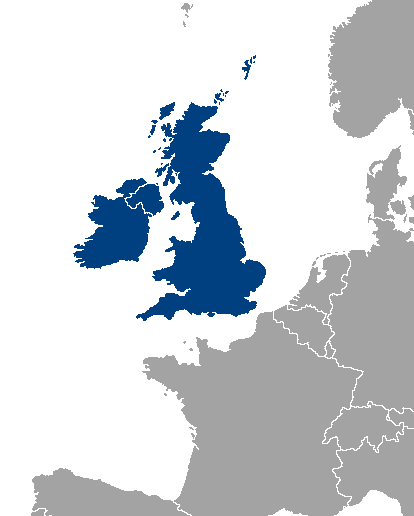United Kingdom of Great Britain and Ireland
From Wikipedia, the free encyclopedia.
|
|||||
| Royal motto: Dieu et mon droit (French: God and my right)1 |
|||||
 |
|||||
| Capital | London | ||||
| Head of State | King of the United Kingdom of Great Britain and Ireland | ||||
| Head of Government | Prime Minister | ||||
| Parliament | House of Commons, House of Lords | ||||
- This article is about the historical state called the United Kingdom of Great Britain and Ireland (1801-1927). For information about its modern successor states, see the main articles: United Kingdom and Republic of Ireland.
The United Kingdom of Great Britain and Ireland, was created on 1 January 1801 by the merger of the Kingdom of Great Britain (itself a merger of the former Kingdoms of Scotland and England in 1707) and the Kingdom of Ireland. The merger followed the Irish Rebellion of 1798, and was facilitated by the Act of Union, passed by both the Irish Parliament and the British Parliament. The British government awarded gifts of titles, land and money to Irish Members of Parliament to encourage their support for the merger, since most of them had previously been against union. Under the terms of the merger, the Irish Parliament was abolished, and Ireland was to be represented in the united parliament, meeting in the Palace of Westminster. Part of the trade-off for Irish Catholics was to be the granting of Catholic Emancipation, which had been fiercely resisted by the all-Anglican Irish Parliament. However, this was blocked by King George III who argued that emancipating Roman Catholics would breach his Coronation Oath.
Whilst the Irish Free State became independent in 1922, after the Anglo-Irish War, the United Kingdom of Great Britain and Ireland continued in name until 1927 when it was renamed as the United Kingdom of Great Britain and Northern Ireland in accordance with the Royal and Parliamentary Titles Act 1927.
Contents |
Controversy
The Union was never very popular among the majority of the Irish population. Generations of Irish leaders campaigned to establish home government in Ireland. Daniel O'Connell successfully forced the British Government to grant Catholic Emancipation in 1829, by winning election to Westminster and refusing to take the Oath of Supremacy. However, his campaign to repeal the Act of Union failed. Later leaders, such as Charles Stewart Parnell, campaigned for a version of Irish self-government called Home Rule within the United Kingdom, which was nearly achieved in the 1880s under the (British) ministry of W.E. Gladstone. However, the measure was defeated in Parliament, and following the ascension of the Conservatives to the majority, the issue was buried as long as that party was in power. The constant delaying of Home Rule created the frustration that eventually led to political violence and independence.
In 1919, Sinn Féin MPs elected to Westminster formed a unilaterally independent Irish parliament in Dublin, Dáil Éireann with an executive under the President of Dáil Éireann, Éamon de Valera. A War of Independence was fought between 1919 and 1921. Finally in December 1922, twenty-six of Ireland's counties seceded from the United Kingdom of Great Britain and Ireland and formed the independent Irish Free State. Six counties, called Northern Ireland, remained in the United Kingdom, which was renamed the United Kingdom of Great Britain and Northern Ireland in 1927.
List of monarchs
Though the United Kingdom of Great Britain and Ireland effectively came to an end in 1922, the monarch continued to use the title of King or Queen of United Kingdom of Great Britain and Ireland until 1927. Then, under the Royal and Parliamentary Titles Act 1927, new titles were introduced for the British monarch so that he would reign as 'King of the United Kingdom of Great Britain and Northern Ireland', in Britain, and 'King of Ireland', in Ireland.
- George III (1801-1820)
- George IV (1820-1830)
- William IV (1830-1837)
- Victoria (1837-1901)
- Edward VII (1901-1910)
- George V (1910-1922/1927)
See also
External links
| Preceded by: Kingdom of Great Britain 1707-1801 Kingdom of Ireland 1541-1801 |
United Kingdom of Great Britain and Ireland 1801-1922 |
Succeeded by: United Kingdom of Great Britain and Northern Ireland 1922-present Irish Free State 1922-1937 |



